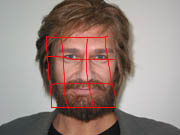Grid analysis
A method for image recognition and automatic classification in computer science is called raster analysis. The image is rasterized (pixelated) into larger parts and then the blurred image is compared with known patterns. In contrast to other methods (such as cluster analysis ), the goal is only to classify the entire object on the image without dividing it into smaller subclasses (global classification).
algorithm
Rasterization
The method of screening can be determined mathematically. To do this, the image points ( pixels ) are transferred into a matrix . The brightness value is entered for black-and-white images, and a 3-tuple of the RGB color values for color images.
A new run is started again and again until the picture can be assigned to a known class.
Line by line applies to pass :
in which:
classification
- the resulting pattern is compared with the known patterns
- if there is no match, a new run of the screening is started
- as soon as an identical pattern is found, the target class is found
- If no identical pattern is found up to the maximum grid, the generated patterns are checked backwards for known similar classes ( i.e. only grid segments are compared)
- as soon as grid segments are the same, the target class has been found
Note: The probability that a target class will not be found is very small with this method. However, there is a risk that the target class is not useful or wrong if the learning phase was too short.
example
To illustrate the global classification, the following example from face recognition :





